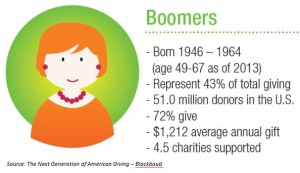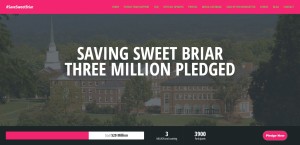
This post is inspired by the incredible outpouring of support in opposition to Sweet Briar College’s Board announcing they plan to close the College, but its themes can be relevant to anyone who has or is working on a fundraising campaign.
As a fundraiser for over 25 years working with all types of groups — schools, nonprofit boards, church stewardship groups, etc. some dynamics often occur. I thought I would gather them together in one place for consideration (and debunking).
Executive Summary (a.k.a. My articles are long so I am summarizing for you here :))
- Warren Buffet or Knight on a White Horse will help us….Nope, while tempting, it is the key stakeholders of any Campaign who will ensure its success (or not).
- A Major Corporation or Foundation will help us….Not likely. Corporations and Foundations have specific goals which often aren’t in sync with a charity and they have complex timelines and grant procedures.
- Bystander Effect…someone else will help us….If you think someone else will step forward — and you don’t have to – you are wrong. Buck the trend and the bystander effect.
- Buy-A-Brick Efforts…and pretty much anything that has a fixed price tag….Cute, fun and good for public relations, but not a sustainable fundraising strategy.
- Major Gift Campaign & Baby Boomers… Major gift campaigns are critical, baby boomers are important, but all ages and demographics can and should be pivotal!
Now for the non Cliff-note version…..WHO can help a fundraising campaign be successful? WHO is essential? YOU! Give now — to your favorite charity or if you want to help Sweet Briar avoid closure, give here.
Warren Buffet Syndrome

The “Knight on a White Horse” or what I also call the “Warren Buffett Syndrome” (my term) occurs when a group discusses how to meet its goal and looks outside of itself. It sounds something like this:
Who knows Warren Buffett (insert wealthy person’s name here who is not affiliated with the institution)? I’ll bet HE would support our cause.
It is true that those who can be the most generous are critical to any fundraising campaign’s success — 80% of the funds come from 20% of the people and sometimes it is an even narrower margin. But in nearly all cases with only extreme exceptions, the supporters of a fundraising campaign are the stakeholders of that institution: students, service recipients, parents, alumni, community.
The exception to this is when someone has a close personal or professional relationship to a celebrity or benefactor and can make a personal appeal. I have ONLY seen this work when someone has a long-time personal relationship built on trust with reciprocity when their request for support is in alignment with the benefactor’s charitable goals. A person not associated with an individual trying to get a message through has never worked in my experience. That doesn’t mean it isn’t worth trying, but I would never want others to sit back and not think their own contributions were important when they hear of a possible “savior”….
The exception to this is when someone has a close personal or professional relationship to a celebrity or benefactor and can make a personal appeal. I have ONLY seen this work when someone has a long-time personal relationship built on trust with reciprocity when their request for support is in alignment with the benefactor’s charitable goals. A person not associated with an individual trying to get a message through has never worked in my experience. That doesn’t mean it isn’t worth trying, but I would never want others to sit back and their their own contributions were not important when they hear of a possible “savior”….

A Large Corporation or Foundation will help us….
Charitable Foundations and Corporate Foundations are another often misunderstood source of support. People hear of large holdings of Foundations and see large grants and think:
If ONLY we appealed to (insert name of famous Foundation), I’ll bet THEY would help us….
While it is true that Foundations and Corporations make generous gifts to institutions, it is always aligned with the core mission of those entities. In Corporations, there is usually a return-on-investment goal meaning they give, but they also wish to boost their brand, hire talent, etc. Foundations have specific missions to achieve and their grants come with complex reporting requirements which institutions often find onerous and sometimes realize to accept the funds they are diverting from their mission. There are also timetables for submissions and often closed processes for inquiring about support. In a fundraising Campaign with any sense of urgency, large foundations and corporations are rarely a solution. Family foundations, on the other hand, are often a good solution to a short-term need; however, there is always a personal connection to someone serving on a family foundation for a gift to come.
Bystander Effect

The other dynamic that causes fundraising campaigns to be sluggish is the phenomenon of bystander effect and bystander apathy. This socio-psychological effect is when a bystander will offer no assistance to a victim of something if others are present. The more people there are, the less likely someone is apt to step forward. In fundraising, it is the idea that someone thinks others are stepping forward and their support isn’t needed. The more successful the Campaign, the more people assume others have stepped forward.

Buy-A-Brick Efforts…and pretty much anything that has a fixed price.
People love buy-a-brick efforts. And there is nothing wrong with them. The problem is this: Anything that has a price tag takes a donor’s charitable ability and reduces it down to a fixed price. Successful campaigns rarely succeed on these efforts alone. I’ve seen fundraising committees thrilled that they got a $100 brick from someone when that individual is giving six and seven figure gifts to other charities. Furthermore, usually the profit that comes off of an item is a small portion of what actually comes back to help a cause. This is not to say that the efforts aren’t worth it, they ARE (particularly for public relations purposes such as anything visible that helps get the brand and message out for a cause). It is just important to know that funds allocated to the cause itself and given outright and tremendously important and should be considered first before purchasing items where a percentage is given. The other down-side to these efforts is that the portion that could be tax-deductible is usually negligible.
I have been absolutely delighted to see the outpouring of support in response to the Saving Sweet Briar College movement. There is an entire website dedicated to all of the various things people are doing to help the College from t-shirts to stick-on nails to even tattoos. This is absolutely wonderful and inspiring. The important thing though is that people who purchase these things also make sure that they can – if they are able – make a direct and generous contribution to the cause itself. Here is a sample of the amazing creative and dedicated projects devoted to Saving Sweet Briar:
https://www.facebook.com/Sweetbriaralumnaegoods
Major Gift Efforts & Baby Boomers…ALL ages and demographics count.

It is true that 43% of total giving by individuals comes from Baby Boomers, but that also means that 57% comes from all other generations. Millennials are an incredibly passionate generation volunteering for causes they care about at a faster and larger rate than all other generations combined. Millennials are also generous.

It is also false that “changing demographic trends” lead to less giving or an inability to conduct a fundraising campaign.
Sweet Briar determined in 2011 that the alumnae’s changing demographics made it impossible to effectively conduct a large-scale fundraiser, Sweet Briar’s vice president for finance Scott Shank told The News & Advance.
This. Is. Bunk. In fact, diversity of institutions has strengthened giving and communities. Furthermore, socio-economic diversity DOES NOT mean families and alumni cannot give or become donors themselves. In fact, data shows that some of the most generous donors to Schools and Colleges are not from wealthy families, but rather are those who received scholarships and felt a duty to give back. Scholarship recipients are also far more likely to be loyal donors — critical to an institutions long term success.
What is missing from the Saving Sweet Briar College efforts is a major gift effort. Peer-to-peer, alumna-to-alumna requests to give, to give generously and to give more than the individual thought possible. These types of efforts are the backbone of any strong fundraising campaign. It is the next step in Saving Sweet Briar reaching its goals. How can you give a major gift? Give monthly, seek matching gifts, enroll your friends.
A small group of committed women can do amazing things, great example:

In the meantime, WHO is the best person to reach a fundraising goal?

If you have read this far, PLEASE make a donation at this link.
Stacey Sickels Locke is a proud graduate of Sweet Briar College, Class of 1988. She served as an employee of the College in the early 1990s working on the $25 million Campaign. During that time, she solicited many leadership gifts which make up the current endowment and she feels a sense of duty that those donations are not used for the closure of the College or for any other purposes than the donors intended. Since then, she has spent her career building support for higher education and the nonprofit community as a staff member and consultant for boards. As a volunteer, she has served Sweet Briar since graduation as a fundraiser, admissions ambassador and now advocate for the #saveSweetBriar movement. She is a member of the Association of Fundraising Professionals (AFP), the Council for the Advancement and Support of Education (CASE) and holds a Certified Fund Raising Executive (CFRE) certification from CFRE International.

Follow us....
Share this....
